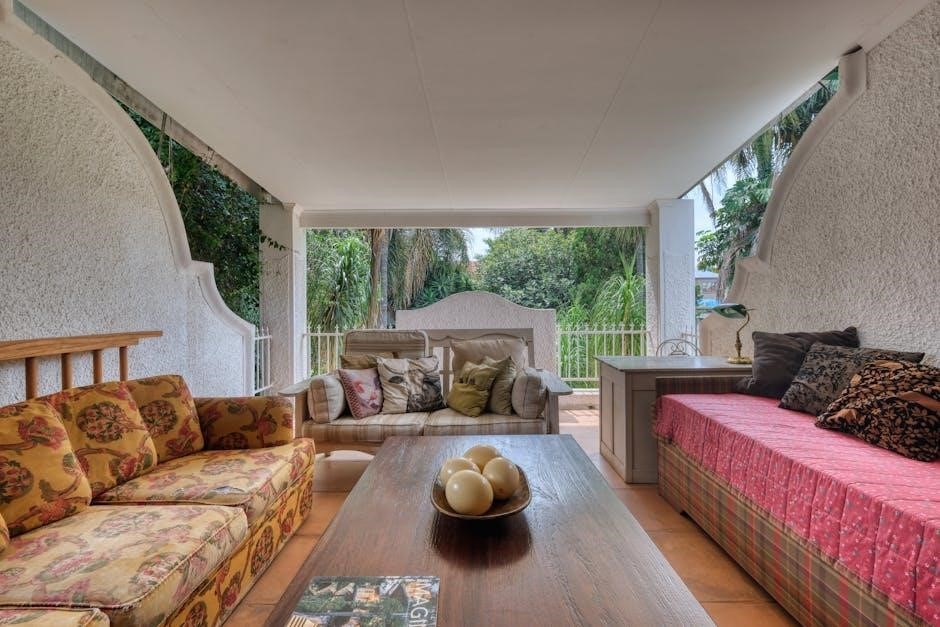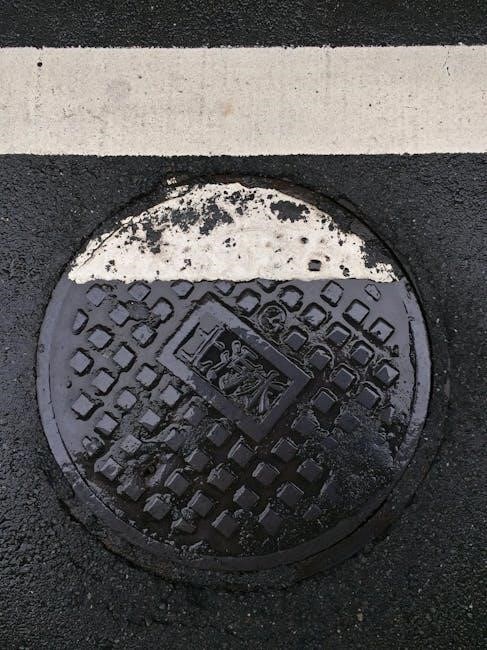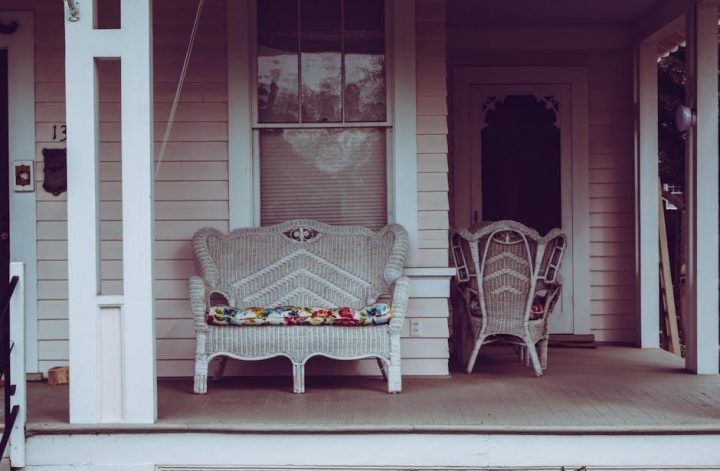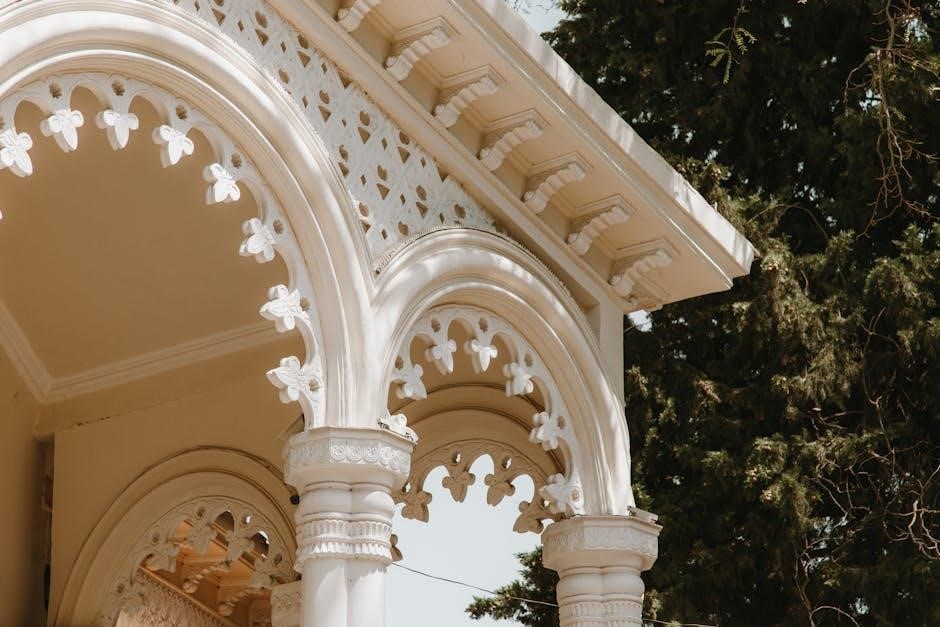Discover how to create shaded outdoor spaces with patio cover plans. These guides offer detailed designs‚ from modern to traditional styles‚ using materials like wood or metal for durability and aesthetic appeal. Perfect for DIY enthusiasts‚ these PDF plans provide step-by-step instructions to enhance your home’s exterior beautifully.
What Are Patio Cover Plans?
Patio cover plans are detailed DIY guides that help homeowners design and build shaded outdoor spaces. These plans typically include materials lists‚ measurements‚ and step-by-step instructions. Available in PDF formats‚ they cater to various styles‚ such as lean-to or sloped designs. Whether you prefer wood‚ metal‚ or other materials‚ these plans provide a blueprint for creating a functional and aesthetically pleasing patio cover. They often feature adjustable dimensions‚ allowing customization to fit different yard sizes and architectural styles. By following these plans‚ you can enhance your outdoor living area with a durable and attractive structure that provides shade and protection from the elements. Many free and premium options are available online‚ making it easy to get started on your project;
Benefits of Having a Patio Cover
Installing a patio cover offers numerous benefits‚ enhancing both functionality and aesthetics. It provides shade‚ protecting you from direct sunlight and creating a comfortable outdoor space for relaxation and entertainment. A patio cover also shields your furniture and flooring from weather damage‚ extending their lifespan. Additionally‚ it adds to your home’s curb appeal and can increase property value. With a patio cover‚ you can enjoy your outdoor space year-round‚ regardless of weather conditions. It also serves as a versatile area for dining‚ gardening‚ or recreational activities. Whether you choose wood‚ metal‚ or another material‚ a patio cover is a practical and stylish investment for any homeowner seeking to maximize their outdoor living experience.
Types of Patio Covers
Patio covers come in various styles and materials to suit different needs and preferences. Wooden patio covers are traditional and durable‚ offering a natural aesthetic‚ while metal covers provide modern appeal with low maintenance. Fabric covers are versatile and lightweight‚ ideal for temporary shade. Gabled patio covers feature a sloped roof‚ allowing snow to slide off‚ while lean-to designs attach to the house‚ offering a sleek look. Flat roof covers are minimalist and blend seamlessly with contemporary architecture. Each type offers unique benefits‚ from durability to style‚ ensuring there’s an option for every homeowner. The choice depends on local weather conditions‚ budget‚ and desired aesthetic‚ making patio covers a flexible solution for outdoor spaces.

Design Factors for Patio Covers
Key design factors include roof load calculations‚ local building codes‚ and site-specific requirements. Ensure structural integrity and compliance with regulations for a safe and durable patio cover.
Roof Design Load and Local Building Codes
When designing a patio cover‚ calculating the roof design load is crucial. This load combines the dead load (weight of materials) and live load (additional weight like snow). Local building codes provide specific requirements for these calculations‚ ensuring safety and structural integrity. For example‚ the International Building Code offers guidelines‚ but local regulations may vary. Ensure compliance by referencing your area’s building codes. Proper planning prevents structural failure and ensures durability. Additionally‚ obtaining necessary permits and inspections guarantees adherence to safety standards. Always consult local authorities to confirm requirements before construction begins. This step is vital for a secure and long-lasting patio cover.
Site Plan Requirements
A site plan is essential for patio cover projects‚ providing a detailed layout of your property. It must be drawn to scale and include the location of the patio cover‚ property lines‚ setbacks‚ and nearby structures. The plan should clearly show the size and shape of the patio cover‚ its distance from boundaries‚ and any existing features like decks or gardens. Including notes about roofing material and structural elements is also recommended. This plan helps ensure compliance with local building codes and zoning regulations. Submitting a comprehensive site plan simplifies the permit approval process and ensures your project aligns with neighborhood guidelines. Accurate details are crucial for a successful submittal.
Foundation and Roof Plan Details
The foundation and roof plan details are critical for a sturdy patio cover. The foundation plan outlines the placement and depth of footings and anchor points‚ ensuring stability. It must specify materials like concrete or galvanized post anchors for securing posts to the slab. The roof plan details the framing structure‚ including rafters‚ beams‚ and joists‚ and the type of roofing material‚ such as metal or wood. Cross-sections and elevation views provide clarity. Compliance with local building codes is essential‚ especially for load-bearing capacities. Proper detailing ensures the patio cover withstands environmental stresses and remains safe. These plans are vital for both DIY projects and professional constructions‚ guiding accurate execution.

Materials for Patio Covers
Explore durable materials for patio covers‚ including wood‚ metal‚ and more. Each offers unique benefits‚ ensuring longevity and style for your outdoor space.
Wooden Patio Cover Materials
Wooden patio covers are a popular choice for their natural beauty and durability. Western Red Cedar‚ pressure-treated pine‚ and redwood are commonly used materials due to their resistance to rot and insects. Cedar is favored for its aromatic properties and attractive grain‚ while pressure-treated pine offers affordability and durability. Proper sealing and staining can extend the lifespan of wooden patio covers‚ making them last for 20 to 30 years. However‚ without proper maintenance‚ wood can warp‚ split‚ or rot over time. Always consider local building codes and load requirements when selecting wooden materials for your patio cover project.
Metal Patio Cover Materials
Metal patio cover materials are highly durable and low-maintenance‚ making them a great choice for outdoor structures. Galvalume metal roofing is a popular option due to its resistance to rust and weathering. Aluminum patio cover kits are another excellent choice‚ offering a lightweight yet sturdy framework. Steel materials‚ while heavier‚ provide exceptional strength and can withstand heavy loads‚ including snow. Metal patio covers are also fire-resistant and require less upkeep compared to wood. They come in various finishes and can be designed to match modern or traditional aesthetics. Proper installation ensures longevity‚ and many metal patio covers come with pre-engineered designs for ease of construction;
Comparison of Material Durability
When comparing materials for patio covers‚ durability is a key factor. Wooden patio covers‚ such as those made from Western Red Cedar or pressure-treated pine‚ offer a natural aesthetic but may require more maintenance. Cedar can last 20-30 years with proper care‚ while pressure-treated pine may last 10-15 years. Metal patio cover materials‚ such as Galvalume or aluminum‚ are more durable and low-maintenance‚ often lasting decades with minimal upkeep. Metal is also resistant to rot‚ insects‚ and weathering‚ making it a practical choice for outdoor structures. However‚ wood provides a warmer‚ more traditional look‚ while metal offers a sleek‚ modern appearance. The choice depends on desired aesthetics‚ budget‚ and maintenance preferences.

Construction Steps for Patio Covers
Building a patio cover involves preparing the site‚ installing posts and beams‚ and adding rafters and roofing material. Ensure all steps comply with local building codes.
Preparing the Site and Foundation
Proper site preparation is essential for a stable patio cover. Clear the area of debris and vegetation‚ ensuring a clean workspace. Mark the corners of your patio cover with stakes and string to define the perimeter. Check for underground utilities to avoid damage. Dig footings for the posts‚ ensuring they meet local building codes for depth and width. Pour concrete into the footings and set galvanized post anchors to secure the posts. Allow the concrete to cure completely before proceeding. Ensure the site is level and the foundation is sturdy to support the weight of the patio cover materials. Proper preparation ensures a safe and durable structure.
Installing Posts and Beams
Begin by attaching the posts to the concrete footings using galvanized post anchors for durability. Ensure the posts are plumb and secure with concrete screws. Once the posts are set‚ install the beams horizontally across the top of the posts‚ creating the frame for the roof. Use high-strength galvanized lag screws or brackets to secure the beams to the posts. Double-check that the beams are level and evenly spaced to support the weight of the rafters and roofing material. Proper alignment and secure fastening are crucial to ensure the structure’s stability and safety. Follow the measurements and spacing outlined in your patio cover plans to achieve a professional finish.
Adding Rafters and Roofing Material
After the beams are secure‚ begin installing the rafters perpendicular to the beams‚ spaced evenly according to your patio cover plans. Ensure the rafters are level and aligned properly. Once the rafters are in place‚ attach the roofing material‚ such as metal panels or shingles‚ following the manufacturer’s instructions. Secure the material tightly to the rafters to prevent gaps or movement. Finish by installing roofing underlayment and flashing around edges and valleys to ensure water tightness. Finally‚ inspect the entire structure to confirm all components are properly aligned and securely fastened before moving on to the final touches.

Legal and Permit Requirements
A building permit is often required for patio covers‚ especially if they exceed a certain size or are attached to a structure. Always check local building codes and submit detailed plans for approval before construction begins. Ensure compliance with inspections and regulations to avoid legal issues.
When a Building Permit Is Required
A building permit is typically required for patio covers that exceed specific size limits or are attached to a structure. For example‚ covers over 200 square feet or those not exempt under local codes may need a permit. Attached patio covers usually require approval‚ while detached ones under a certain size might be exempt. Always verify with local building codes‚ as requirements vary by jurisdiction. Submitting detailed plans‚ including site maps and construction details‚ is essential for approval. Even if a permit isn’t mandatory‚ ensuring compliance with local regulations is crucial for safety and legal standards.

Submittal Requirements for Patio Cover Plans
When submitting patio cover plans for approval‚ ensure compliance with local building codes. Plans must include a detailed site plan‚ showing the patio’s location and dimensions‚ and a foundation plan outlining footings and posts. A roof plan with rafters and roofing material details is also required. Elevations and cross-sections should illustrate the structure’s height and design. Additionally‚ include a material takeoff list and any electrical details. Submit two sets of plans‚ preferably sized 11×17 inches‚ drawn to scale. Some jurisdictions may require specific forms‚ like the Patio_Handout_LA_02/2018‚ for detached or attached patio covers; Ensure all documents are complete and accurate to avoid delays in approval.

Inspections and Compliance
Ensure your patio cover meets local building codes by scheduling mandatory inspections. Start with a foundation inspection to verify footings and posts are correctly installed. After framing‚ a structural inspection checks beams and rafters for proper alignment and secure connections. If electrical features are included‚ an electrical inspection is required to ensure safety and code compliance. Finally‚ a final inspection confirms all work meets standards. Compliance with local regulations is crucial to avoid fines or removal of the structure. Keep all inspection approvals on file for future reference. Proper compliance ensures safety and durability of your patio cover‚ while also maintaining property value and legal standing;

Additional Features and Considerations
Enhance your patio cover with lighting‚ electrical outlets‚ or ceiling fans for functionality. Consider ventilation and shading options to maximize comfort. Landscaping integration ensures a seamless aesthetic with your yard‚ creating a cohesive outdoor space tailored to your lifestyle and design preferences.
Designing for Shade and Ventilation
When creating a patio cover‚ proper shade and ventilation are essential for comfort. Consider the angle and pitch of the roof to ensure optimal sunlight filtration. Open designs with spacing between rafters allow airflow‚ preventing heat buildup. For areas with high humidity‚ incorporating fans or louvers can enhance ventilation. Shade can be maximized with wider overhangs or adjustable roofing materials. Additionally‚ integrating plants or screens around the patio further enhances shade and aesthetic appeal. Proper planning ensures your space remains cool and inviting year-round‚ making it ideal for outdoor gatherings and relaxation.
Incorporating Lighting and Electrical Features
Incorporating lighting and electrical features into your patio cover enhances functionality and ambiance. Consider installing recessed lights‚ string lights‚ or ceiling fans for a cozy atmosphere. Electrical outlets and USB ports are practical additions for powering devices or outdoor entertainment systems. Plan the layout carefully to ensure safe and efficient wiring‚ adhering to local building codes. Weather-resistant materials and GFCI outlets are recommended for outdoor use. A well-designed electrical system extends your outdoor living space’s usability into the evening and improves overall safety. These features not only add convenience but also increase your patio’s aesthetic appeal and value.
Landscaping and Aesthetic Integration
Landscaping and aesthetic integration are crucial for creating a seamless transition between your patio cover and the surrounding environment. Choose materials and designs that complement your home’s architecture and yard. Incorporate plants‚ flowers‚ or greenery around the structure to enhance its natural appeal. Consider the color and texture of roofing materials to match your home’s exterior. Adding decorative elements like vines or hanging plants can further blend the patio cover into the landscape. Proper integration ensures the space feels cohesive and inviting‚ extending your living area while maintaining harmony with nature. This approach not only beautifies your outdoor space but also increases your home’s curb appeal and value.

Maintenance and Care
Regular maintenance ensures your patio cover remains durable and attractive. Clean debris‚ inspect for damage‚ and apply protective treatments to extend its lifespan and keep it looking new.
Regular Maintenance Tips
Regular maintenance is essential to prolong the life of your patio cover. Start by clearing debris like leaves and branches from the roof to prevent water accumulation. Inspect the structure for signs of damage‚ such as cracks or rot‚ and address them promptly. For wooden covers‚ apply a waterproof sealant or stain annually to protect against moisture and UV exposure. Metal covers should be cleaned regularly to avoid rust and corrosion. Check fasteners and tighten any loose screws or bolts. Trim nearby vegetation to prevent overgrowth from damaging the structure. Additionally‚ ensure proper ventilation to reduce humidity and prevent mold growth. By following these tips‚ you can maintain your patio cover’s integrity and ensure it remains a safe and enjoyable space for years to come.
Common Issues and Repairs
Common issues with patio covers include weather damage‚ structural instability‚ and material degradation. Address these problems early to prevent costly repairs. Leaks are often caused by damaged roofing materials or poor installation. Inspect and replace worn-out roofing panels or seal gaps with appropriate sealants. Sagging rafters or beams may indicate weak supports; reinforce them with additional brackets or braces. For wooden structures‚ rot and insect damage are prevalent. Treat affected areas with preservatives or replace rotten wood. Metal covers may rust over time; apply rust-inhibiting coatings to prevent further deterioration. Regularly inspect post-to-beam connections and tighten any loose fasteners. Addressing these issues promptly ensures your patio cover remains sturdy and functional‚ providing years of reliable service.
Extending the Lifespan of Your Patio Cover
Regular maintenance is key to extending the lifespan of your patio cover. Clean debris from the roof to prevent water accumulation and damage. Inspect wooden structures for rot or insect damage and treat with preservatives. For metal covers‚ apply rust-inhibiting coatings to prevent corrosion. Tighten loose fasteners and ensure post-to-beam connections are secure. Use high-quality‚ weather-resistant materials during construction to withstand harsh conditions. Apply sealants to gaps and cracks to protect against moisture. Schedule annual inspections to address minor issues before they escalate. Proper care and timely repairs can significantly extend the durability of your patio cover‚ ensuring it remains a functional and beautiful outdoor space for years to come.

Free Patio Cover Plans in PDF Format
Access free downloadable patio cover plans in PDF format‚ offering detailed designs and step-by-step instructions for building wooden or metal covers. Find modern and traditional styles to suit your space‚ ensuring professional results with easy-to-follow guides.
Where to Find Free Downloadable Plans
Find free patio cover plans in PDF format online through DIY project websites‚ woodworking platforms‚ and home improvement resources. Websites like MyOutdoorPlans and Ana-White offer detailed patio cover designs‚ including lean-to‚ gable‚ and pergola styles. These plans often include step-by-step instructions‚ material lists‚ and diagrams to help you construct your patio cover. Some sites provide premium plans for a fee‚ offering advanced features like customizable designs and 3D models. Additionally‚ local hardware stores or building departments may offer free or low-cost patio cover plans tailored to local building codes. Always verify the source for accuracy and ensure the plans meet your specific needs and skill level.
Features of Premium and DIY Plans
Premium patio cover plans offer advanced features like customizable designs‚ 3D models‚ and detailed engineering specifications‚ ensuring compliance with local building codes. They often include step-by-step instructions‚ material lists‚ and cost estimates‚ making them ideal for complex projects. DIY plans‚ while more basic‚ provide essential guidance for simpler structures‚ including PDF downloads of layouts and construction tips. Premium plans may also offer customer support and editable blueprints‚ whereas DIY plans are typically static and free. Choose premium for large or intricate designs‚ and DIY for smaller‚ straightforward projects. Both options cater to different skill levels and budgets‚ helping you achieve professional-grade results.
Step-by-Step Instructions in PDF Guides
Premium patio cover plans in PDF format provide comprehensive‚ step-by-step instructions for constructing a durable and stylish patio cover. These guides typically include detailed diagrams‚ material lists‚ and construction tips to ensure a seamless process. From preparing the site to installing rafters and roofing material‚ every phase is clearly outlined. Many PDF plans also feature adjustable designs‚ allowing customization to fit your space and preferences. Additionally‚ some guides offer 3D models and engineering specifications for complex projects. Whether you’re a DIY enthusiast or a professional‚ these PDF guides are designed to help you achieve a professional-grade patio cover with minimal errors. They often include troubleshooting tips and maintenance advice to extend the lifespan of your structure.











